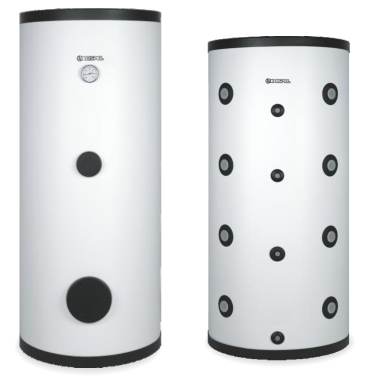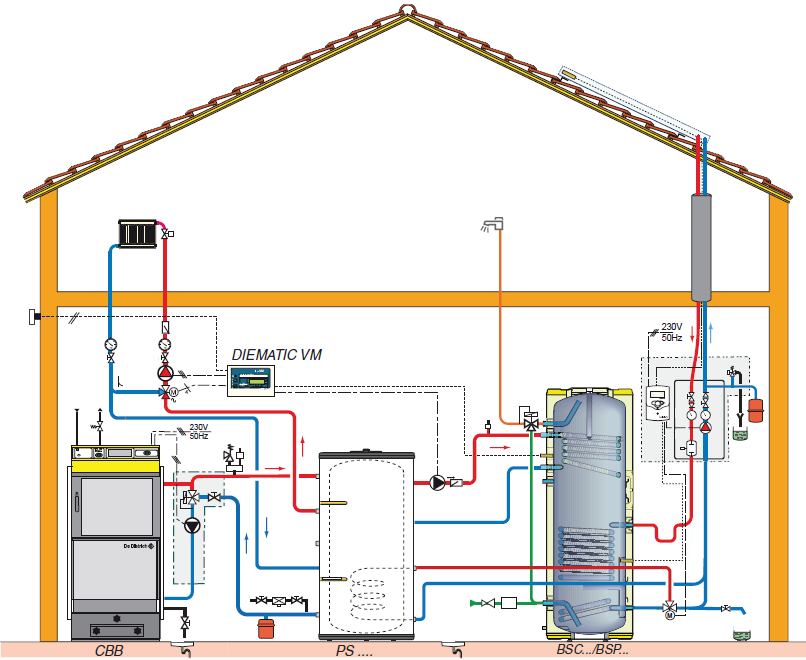Information - About heating systems
Buffer tanks: efficient heat storage and sustainable energy use
Buffer tanks: efficient heat storage and sustainable energy use
Author: Akvedukts
Buffer tanks or thermal storage tanks is the technological solution that allows you to store and efficiently use the heat generated during the energy production process or when it is available at a lower cost. These tanks are able to store excess heat, which can then be used for heating purposes when energy demand is high or when generated energy is expensive. Thermal storage is a valuable and efficient way to optimize energy use, reduce costs and help build a sustainable energy future. They offer many benefits and are one of the leading solutions for energy efficient heating.
Types and Construction of Thermal Storage Tanks
The principle of operation of the buffer tank is to store heat for later use. These tanks usually contain a thermally conductive material, such as water or stone, that can absorb and store heat. When a heat generator such as a boiler or solar collector produces excess heat, it is transferred to a tank where it is stored.
The classification of storage tanks depends mainly on the heat storage material used in them. The most commonly used storage tanks in heating systems use water as the heat storage medium. It is a readily available material with good heat storage properties. Accumulation tanks can also be used that use stone for heat storage, which has higher heat storage properties. Other materials are also used for heat storage where their different physical properties, such as changes in aggregate state, provide the most efficient heat storage and return processes. Layered storage tanks use different materials in layers to store and distribute heat. Akvedukt's product range includes storage tanks using water as the heat storage material.
The design of the storage tanks is mainly based on the characteristics of the material used, its most efficient use and the ease of use of the storage tank. The larger the volume of the storage tank, the more heat it can store. The choice of the volume of the storage tank is determined by the amount of excess heat energy produced by the heat generator that would be useful to store for later use, or by the amount of required heat energy that is planned to be stored in the storage tank.
Different storage solutions will be suitable for specific needs and conditions. The choice is usually made on the basis of energy efficiency, cost, heating needs and environmental considerations.

Image: Buffer tanks SE and SW by Kospel
Operation of buffer tanks
The principle of a buffer tank in a heating system is to store heat and use it later when demand is higher or energy availability is favorable. Here are the basic principles of buffer tank operation in a heating system:
Heat accumulation. Heating system thermal storage tanks come into operation when excess heat is generated. For example, from heat production processes or from solar panels. This excess heat is transferred to a tank where it is stored in a heat conducting substance such as water.
Heat storage. The heat stored in the tank is retained until it is needed. The heat storage capacity of a tank is directly related to the physical properties of the heat transfer material used in the tank.
Heat Recovery. When the heat required for the heating system or hot water production is not provided by the boiler or solar collector, it is supplied by the buffer tank. Using stored heat allows for optimal energy allocation and saves money.
Energy savings and efficiency. The main objective of a buffer tank is to ensure more efficient use of energy, thereby reducing energy costs. By using stored heat, energy can be used when it is available at a cheaper rate or when the demand for energy is higher than the heat generator can provide.
Sustainability and Environmental Impact. Heating storage tanks can have a positive impact on the environment by reducing greenhouse gas emissions and contributing to a more sustainable energy model. Efficient energy use and flexible heat distribution also reduce the burden of energy production and environmental impact.
Buffer Tanks: Advantages and Disadvantages
Each type of thermal storage tank or buffer tank has its own advantages and disadvantages that should be considered when choosing the most appropriate solution. Here are some common advantages and disadvantages:
+ Energy saving. Buffer tanks allow heat to be stored at a lower cost and used when energy demand is high or when energy tariffs are cheaper. This can significantly reduce energy costs and consumption.
+ Extends the life of the heat generator. The storage tank makes it easier to regulate and create more uniform temperature conditions in the heating system, which extends the life of the heat generator - boiler.
+ Flexible heat distribution. The storage tank provides the flexibility to distribute heat as needed. This allows optimal adaptation to changing heat consumption conditions and maximum comfort.
+ Environmentally friendly. The more efficient use of energy offered by storage tanks can reduce greenhouse gas emissions and help reduce environmental impact.
+ Thermal stability. By complementing the heating system with a storage tank, heat is distributed more evenly, which can prevent temperature fluctuations indoors and ensure a comfortable heating experience.
+ Renewable energy integration. Tanks can be connected to renewable energy sources such as solar panels and store heat generated from natural sources.
- Initial cost. Purchasing and installing a tank may require an initial investment that can be higher than other heating solutions. In addition to the cost of the storage tank, there are the costs of piping, connections, seals, and possibly an additional circulation pump.
- Installation Constraints, Space Requirements. The size and location of the storage tank may require additional installation restrictions or modifications to the existing heating system.
- Storage capacity. The limited storage capacity of the tank may be insufficient during very cold weather or periods of high demand.
- Maintenance. Water storage tanks require regular maintenance and service to prevent corrosion or other damage.
It is important to consider specific needs, capabilities and budget to select the most appropriate solution. It is best to consult with professionals to select the optimal thermal storage tank.

Image: Example of a complete heating system including buffer tank. CBB - solid fuel boiler, PS - buffer tank, BSC.../BSP - solar storage tank (DeDietrich)
Installation and Maintenance of Storage Tanks
Installation and maintenance of thermal storage tanks are essential to ensure efficient operation and long tank life. Here are some important things to know about the installation and operation of thermal storage tanks. Installation:
Select the appropriate capacity. The required tank capacity is determined by the characteristics of the heating system, the amount of heat transfer fluid and the recommendations of the manufacturer of the installed heat generator - boiler or heat pump.
Professional installation. To ensure correct and safe installation, it is recommended to use professional installers experienced in such work.
Technical requirements. The installation of the tank must comply with technical requirements and regulations. This includes the correct positioning of the tank, its connection to the heating system and the necessary safety precautions.
Location. The storage tank must be located so that it can perform its function effectively and is easily accessible for maintenance.
Connections. The connections of the storage tank to the heating system shall be hermetic and secure. Improperly made connections can cause leaks and adversely affect the performance of the system.
Operation:
Periodic Inspection. Periodically inspect the tank to ensure that it is functioning properly and that there are no abnormalities or defects. Look for signs of leakage or corrosion.
Maintenance. Follow the manufacturer's instructions for tank maintenance. Be sure to perform the necessary work to maintain the efficiency of the tank. For example, in a domestic water storage tank, the technical condition and deterioration of the corrosion protection anode should be checked periodically.
Heat distribution. Use the tank to efficiently distribute heat according to your needs. Program the heating system to use stored heat when it is needed most.
Safety. Observe safety precautions as some storage tanks can accumulate large amounts of heat. Measures must be taken to prevent overflow and overheating.
Regular maintenance of the heating system. Heat transfer materials and other components used in the storage heater may require periodic maintenance and replacement.
Knowledge. Know and understand how to use a storage tank and how it works. This will help you get the most out of it and avoid undesirable situations.
By following these instructions and performing regular maintenance, you can ensure that your storage tank will work efficiently for a long time.
Akvedukts offers a wide range of storage tanks from multiple manufacturers and all the accessories you need for your heating system. You can see our range of thermal storage tanks in this section of the E-warehouse.
You can buy the products at Akvedukt's Customer Service Centers in Riga, Jelgava, Saldus, Liepāja, Sigulda, Valmiera, Valka, Aluskne, Balvi, Madona and Gulbene.


